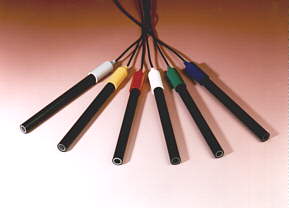
CHM3120L
Introduction to Analytical Chemistry: Laboratory
| Lab Schedule |
| LON-CAPA Pre-Labs |
| Resources |
| Contact Instructor |
| Chemistry Home Page |
![]()
The Fluoride Ion-Selective Electrode: Introduction
The fluoride electrode based on a solid LaF3 membrane is one of the few ion "selective" electrodes that is truly selective for a particular ion, in this case F-. A potentiometric technique, it is routinely used in analytical laboratories and in the field as a cost-effective, reliable method for F- determination. The electrode itself is made from a single crystal of LaF3 sealed into a plastic tube. The LaF3 acts as a membrane which selectively exchanges and transports F- ions. The cavity inside the electrode is filled with a solution containing F- and Cl- ions, and an AgCl coated Ag wire dips into this to make an internal reference electrode, just as in the pH electrode. A separate reference electrode completes the cell. The response of the electrode to F- under the right conditions is very close to ideal.
E(volts) = constant - b(0.059)log[F- in test solution]
The coefficient b is close to 1 (ideal Nernstian). You can determine its actual value from your calibration curve.
Although the electrode is more responsive to F- than almost all other ions by a factor of greater than 1000, OH- ion is an interfering species for which the selectivity coefficient is 0.1. Also, at low pH F exists in the protonated form, HF. All the measurements are thus made in the presence of a buffer, which also stabilizes the total ionic strength of the solution.
A Beginners Guide to Ion-Selective Electrode Measurements